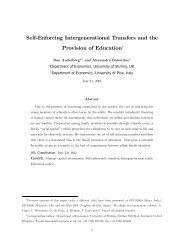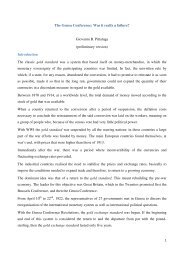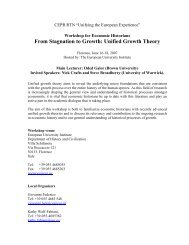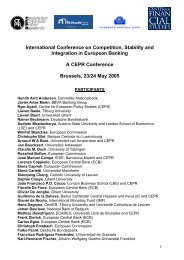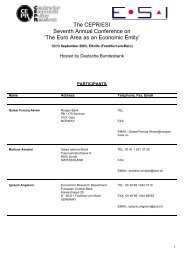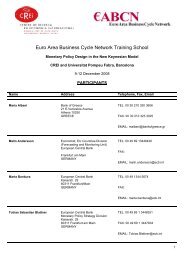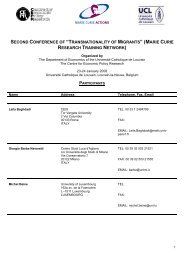MARKET STRUCTURE AND ENTRY: WHERE'S THE BEEF? - CEPR
MARKET STRUCTURE AND ENTRY: WHERE'S THE BEEF? - CEPR
MARKET STRUCTURE AND ENTRY: WHERE'S THE BEEF? - CEPR
You also want an ePaper? Increase the reach of your titles
YUMPU automatically turns print PDFs into web optimized ePapers that Google loves.
variables the number of own and rival outlets in neighboring markets (the number of<br />
outlets of firm i at the beginning of year t in neighboring markets to market j, labeled<br />
OWNNB and RIVALNB respectively).<br />
4.2. Results<br />
We first look at the market characteristics (probit results) in Table IV. For BK, we<br />
find that AREA carries an insignificant coefficient, POPulation a significant positive<br />
coefficient, and POPAR and PENSION negative and significant (at 6% level)<br />
coefficients. The considerable importance of population for BK is similar to the results<br />
reported by BR in their various papers. We find that none of the market characteristics<br />
affects McD’s entry decisions. Unemployment (UE) and the level of the council tax<br />
(CTAX) do not seem to matter to either firm. We also find that for neither firm is there a<br />
London effect in the data as LONDON obtains an insignificant coefficient. Our controls<br />
for market definition obtain significant coefficients for BK, and insignificant ones for<br />
McD. The LPM estimates are in line with the probit findings apart from POPulation<br />
becoming significant for McD.<br />
[TABLE IV HERE]<br />
The variables of most interest however are the market structure variables.<br />
Looking first at BK, we find that all the market structure variables bar M2B1<br />
characterizing structures where McD has more outlets than BK carry positive and<br />
significant coefficients. For McD we observe a clear pattern in that almost all market<br />
structure dummies obtain a positive and significant coefficient. BK is thus – ceteris<br />
paribus - consistently more likely to enter markets where McD is larger than itself, than a<br />
market with no outlets of either firm. McD is more likely to enter markets with either<br />
firm’s outlets, than comparable new markets. The LPM results are again in line with<br />
17



